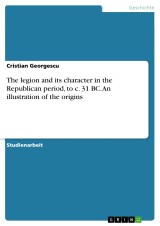Details

The legion and its character in the Republican period, to c. 31 BC. An illustration of the origins
1. Auflage
|
13,99 € |
|
| Verlag: | Grin Verlag |
| Format: | |
| Veröffentl.: | 03.08.2021 |
| ISBN/EAN: | 9783346456991 |
| Sprache: | deutsch |
| Anzahl Seiten: | 18 |
Dieses eBook erhalten Sie ohne Kopierschutz.
Beschreibungen
Studienarbeit aus dem Jahr 2019 im Fachbereich Geschichte - Weltgeschichte - Frühgeschichte, Antike, Note: 1,7, Pädagogische Hochschule Ludwigsburg, Sprache: Deutsch, Abstract: This seminar paper examines the origins of the legion and its character and exploits through the expansion of the Roman empire in the Republican period, to c. 31 BC. However, these legions were ad hoc units within a citizen army, raised on a temporary basis for campaigns and had no lasting identities that we can describe over a period of centuries. Legions as units with stable, long-term histories emerged from the armies of Julius Caesar in Gaul in the mid-1st century BC and of Octavian and Mark Antony in the civil wars of the 40s and 30s BC.
Portraying the Roman imperial Army during the reign of the second emperor, Tiberius, in AD 23, the Roman historian Tacitus enumerates the twenty-five legions that made up the heart of the army, with the areas of the empire in which they were installed. Tacitus also says that there were similar naval units and units of supporting cavalry and infantry ‘not much inferior to them in strength.’
However, Tacitus allocates most attention to the legions, describing their placement region by region, while he explains over the other elements of the armed forces in a couple of sentences. And it is exactly the legions of the Roman army that come to our minds when we think about Roman military strength and effectiveness.
For the Roman historian Tacitus, the legions were vital because they were the high-status units of the army. They were composed of Roman citizens with full Roman legal and political rights, and they still represented the Roman people under arms. Auxiliary troops were recruited largely from allies and subjects, men of mediocre status who aimed to Roman citizenship after a lifetime in the army. Equally important is the fact that in AD 14 the legions already had a history of over three centuries of success. They had formed the core of an army that had boosted Rome from anonymity to domination of the Mediterranean basin and beyond. They had beaten Hannibal, the Macedonians, the Gauls and many others.
The Roman legions had suffered defeats too, but one Roman feature was the capacity to endure losses and rebuild fighting strength, so the legions lived on. They lived on and fought well beyond the age of Augustus. Legions were still essential fighting units in the 5th century AD, when the western empire was in military and political decline.
Portraying the Roman imperial Army during the reign of the second emperor, Tiberius, in AD 23, the Roman historian Tacitus enumerates the twenty-five legions that made up the heart of the army, with the areas of the empire in which they were installed. Tacitus also says that there were similar naval units and units of supporting cavalry and infantry ‘not much inferior to them in strength.’
However, Tacitus allocates most attention to the legions, describing their placement region by region, while he explains over the other elements of the armed forces in a couple of sentences. And it is exactly the legions of the Roman army that come to our minds when we think about Roman military strength and effectiveness.
For the Roman historian Tacitus, the legions were vital because they were the high-status units of the army. They were composed of Roman citizens with full Roman legal and political rights, and they still represented the Roman people under arms. Auxiliary troops were recruited largely from allies and subjects, men of mediocre status who aimed to Roman citizenship after a lifetime in the army. Equally important is the fact that in AD 14 the legions already had a history of over three centuries of success. They had formed the core of an army that had boosted Rome from anonymity to domination of the Mediterranean basin and beyond. They had beaten Hannibal, the Macedonians, the Gauls and many others.
The Roman legions had suffered defeats too, but one Roman feature was the capacity to endure losses and rebuild fighting strength, so the legions lived on. They lived on and fought well beyond the age of Augustus. Legions were still essential fighting units in the 5th century AD, when the western empire was in military and political decline.
Diese Produkte könnten Sie auch interessieren:

Die jungpaläolithische Freilandstation Langmannersdorf an der Perschling, Niederösterreich

von: Tina A Salcher-Jedrasiak, Sandra Umgeher-Mayer

57,00 €

Beiträge zur Ur- und Frühgeschichte Österreichs, Band 90/2006

von: Institut für Ur- u.Frühgeschichte Universität Wien

73,00 €















